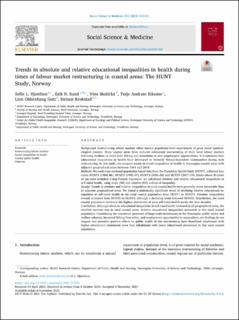| dc.description.abstract | Background
Restructuring labour markets offers natural population-level experiments of great social epidemiological interest. Many coastal areas have endured substantial restructuring of their local labour markets following declines in small-scale fishing and transitions to new employment opportunities. It is unknown how educational inequalities in health have developed in formerly fishery-dependent communities during such restructuring. In this study, we compare trends in social inequalities in health in Norwegian coastal areas with adjacent geographical areas between 1984 and 2019.
Methods
We used cross-sectional population-based data from the Trøndelag Health Study (HUNT), collected four times: HUNT1 (1984–86), HUNT2 (1995–97), HUNT3 (2006–08) and HUNT4 (2017–19). Adults above 30 years of age were included. Using Poisson regression, we calculated absolute and relative educational inequalities in self-rated health, using slope (SII) and relative (RII) indices of inequality.
Results
Trends in absolute and relative inequalities in rural coastal health were generally more favourable than in adjacent geographical areas. We found a statistically significant trend of declining relative educational inequalities in self-rated health in the rural coastal population from HUNT1 to HUNT4. Absolute inequalities overall increased from HUNT1 to HUNT4, although a declining trend followed HUNT2. Nonetheless, the rural coastal population exhibited the highest prevalence of poor self-rated health across the four decades.
Conclusions
Although absolute educational inequalities in self-rated health widened in all geographical areas, the smallest increase was in rural coastal areas. Relative educational inequalities narrowed in this rural coastal population. Considering the concurrent processes of large-scale investments in the Norwegian public sector and welfare schemes, increased fishing fleet safety, and employment opportunities in aquaculture, our findings do not suggest that potential positive effects on public health of this restructuring have benefitted inhabitants with higher educational attainment more than inhabitants with lower educational attainment in this rural coastal population. | en_US |

